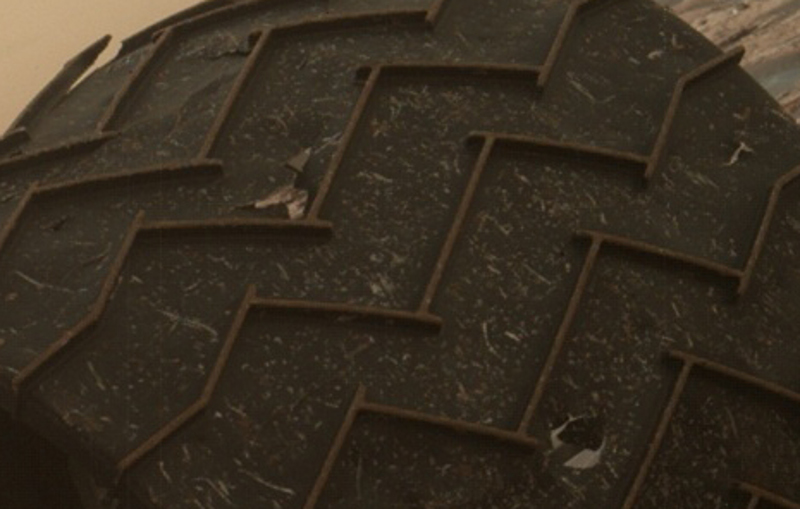A routine check performed by NASA has uncovered two tears on the treads of the Mars Curiosity Rover’s left middle wheel. The damage isn’t unexpected, nor is it catastrophic, but it’s a reminder that this intrepid little explorer won’t last forever.
Two treads, or grousers, on Curiosity’s left middle wheel are broken. In this image, a torn grouser can be seen at the top of the wheel. (Image: NASA/JPL-Caltech/MSSS)
Scientists with the Curiosity mission noticed the small breaks, both of which are on the rover’s raised treads, on March 19. NASA last took a look at the wheels on January 27 and noticed nothing out of the ordinary, so the damage occurred only recently. NASA obviously isn’t happy about it, but insists the wear-and-tear will not change its current science plans or diminish the rover’s opportunities to study key features on Mars.
“All six wheels have more than enough working lifespan remaining to get the vehicle to all destinations planned for the mission,” said Curiosity Project Manager Jim Erickson, in an agency release. “While not unexpected, this damage is the first sign that the left middle wheel is nearing a wheel-wear milestone.”

A zoomed-in view of the damage. (Image: NASA/JPL-Caltech/MSSS)
Mission planners got a hint that Curiosity’s wheels were deteriorating faster than expected back in 2013, so they began to drive the rover in reverse as a protective measure. Subsequent tests showed that at the stage where three of the raised treads, called grousers, are broken, a wheel will have attained about 60 per cent of its useful lifespan.
While frustrating, the damage needs to be put into perspective. To date, Curiosity has traversed nearly 16km across the rugged Martian surface. Each of the probe’s six aluminium wheels measures 50cm in diameter, which contact the ground with an outer layer that’s as thin as a coin, except at the thicker treads. Each wheel is equipped with 19 of these zigzag-shaped grousers, which have to bear the weight of the rover, and provide traction as the wheels traverse over sand and jagged rocks. Curiosity weighs 899kg on Earth, but since Mars has only about 38 per cent of the surface gravity on Earth, it’s about 340kg on the Red Planet. Still, a pretty heavy machine.
[referenced url=”https://gizmodo.com.au/2016/12/the-curiosity-rover-has-been-out-of-action-for-weeks/” thumb=”https://i.kinja-img.com/gawker-media/image/upload/t_ku-large/typxlefszozx7mpq6yxu.jpg” title=”The Curiosity Rover Has Been Out Of Action For Weeks” excerpt=”NASA is working to resolve an increasingly frustrating problem with the Curiosity Rover’s drill, which has stalled, leaving the Martian explorer out of action on the slopes of Mount Sharp for more than two weeks.”]
It’s full steam ahead until further notice, but this otherwise freakishly reliable probe is starting to show its age. In early December 2016, NASA was unable to move the rover’s drill bit onto rocks. Engineers suspect that debris, like Martian dirt or pebbles, is gumming up the drill feed motor. The problem, which is thankfully intermittent, has yet to be resolved. Then, on February 24, Curiosity’s arm-mounted Mars Hand Lens Imager (MAHLI) failed to open into its fully extended position. NASA is currently conducting diagnostic tests to figure out what’s going on.
[NASA]
